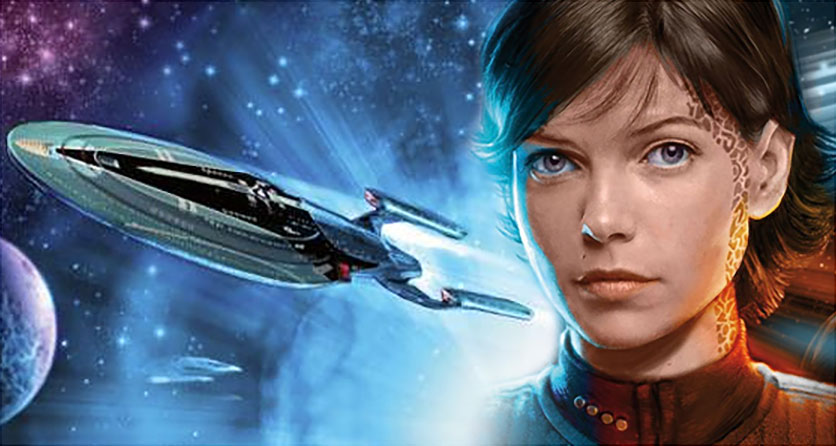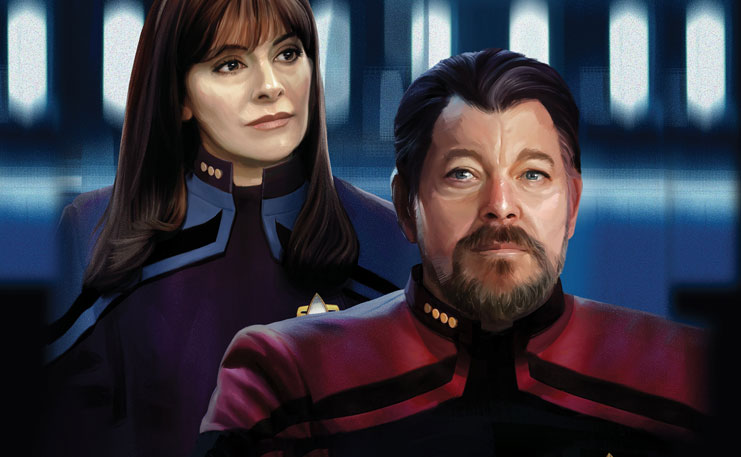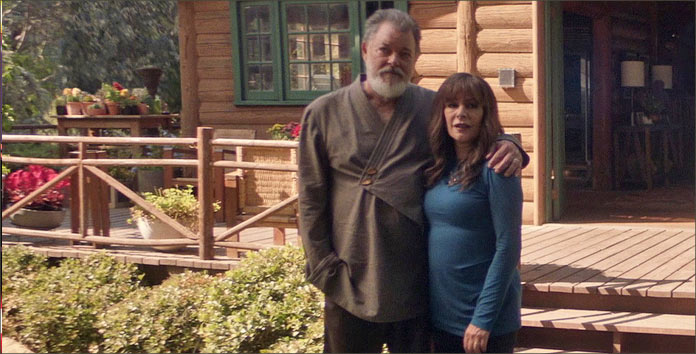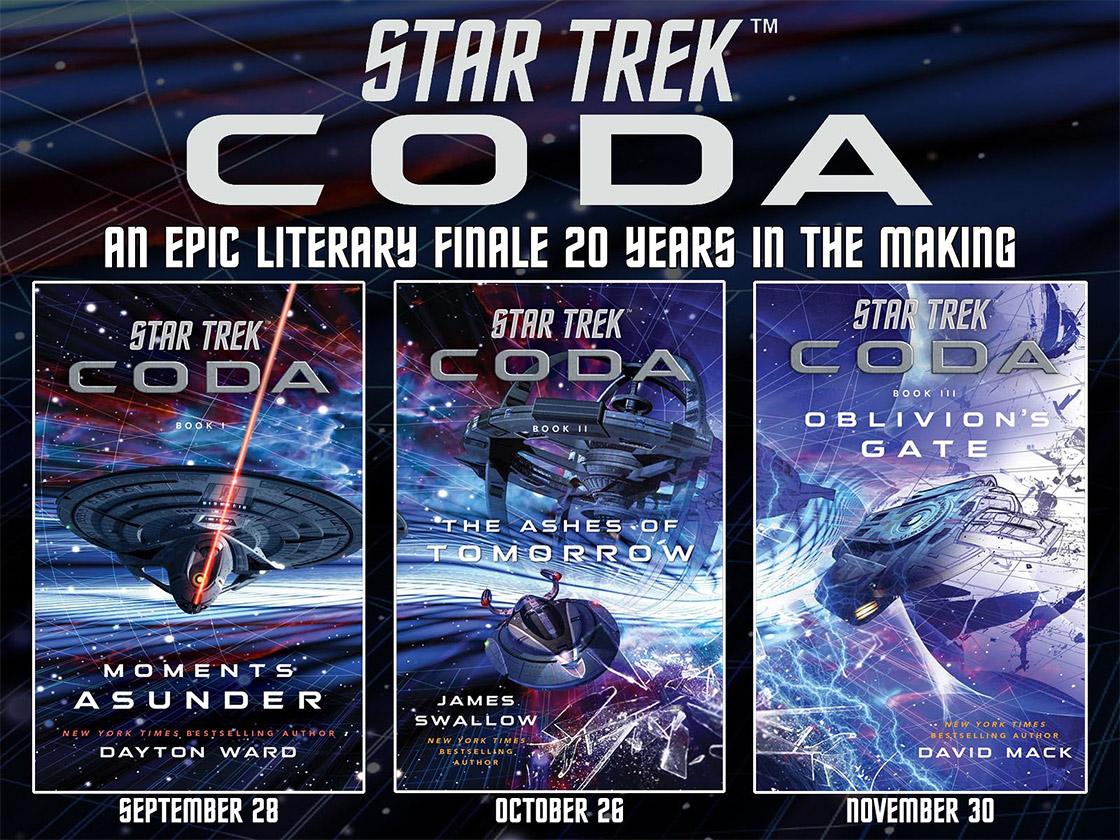The Star Trek: Coda trilogy, the biggest Star Trek book event since 2008’s Borg-ending Destiny trilogy, continued into its second chapter last week with author James Swallow’s The Ashes of Tomorrow.
As we noted in our review last week, the book significantly expands the scope and scale of the Coda story that will bring an end to 20 years of the Star Trek literary continuity – a shared continuity across many of the Star Trek books that have been released since 2001.
Last month, we got the chance to talk to Dayton Ward ahead of the release of his first book in the trilogy, Moments Asunder (read our review here) about the genesis for Coda and the approach that fellow collaborators James Swallow and David Mack took to developing the trilogy.
This month, we’re pleased to bring you an interview with James Swallow himself, where we dive deeper into the Coda story and look at some of the creative choices made along the way.
There are some MAJOR SPOILERS ahead for both Moments Asunder and The Ashes of Tomorrow in our discussion, so if you haven’t read the books yet… you’ve been warned!
TREKCORE: How did you become part of the collaborative team behind the Coda trilogy?
JAMES SWALLOW: Well, to be honest, when I was first approached I actually said no! I had a very strong reaction against it — I thought it was a terrible idea. “We can’t do this,” I thought, with the fanboy part of me just like “No, no, no, we can’t turn the lights off on this. We’ve done too much work. It’s too good. It’s too big. We can’t end it!”
It was Dave Mack who actually brought me around. He said the thing that, really in the end, got me to come on board which is, “If we don’t do this, who will? Who’s going to come and step up and do this? We have to do it with the right kind of hand on the tiller.” He pitched that we had to do it with a degree of respect, and a degree of craft, and we have to tell a new story as well that takes things forward to this conclusion, to run down the curtain as it were.
He said, “Do you really want to miss out on that opportunity to write something that’s epic?” And he was right. I didn’t want to miss out on that. Even if I was reluctant at the beginning, when we got into the idea, I realized there was so much opportunity to tell some really great stories, so how can I not? That was it.
Together with Dayton Ward we collaborated on the entire Coda narrative. If you look at the opening title pages of the book, it doesn’t just say the title of the book and the author name — underneath it says, ‘Star Trek: Coda’ by Dayton Ward, James Swallow and David Mack, because we all collaborated on the overarching story and all of us have our fingerprints on every single story in the trilogy.

TREKCORE: After reading Moments Asunder, it feels like The Ashes of Tomorrow really expands the scope of the story. What role do the first two books play within the trilogy as a whole?
SWALLOW: Moments Asunder is the firm, concrete base on which the other books build. It gives you an idea that this is going to be big, this is going to be epic — and of course, in the conclusion of that first novel, Ezri Dax is killed.
One of the reasons we decided to take a main cast member and do away with them in this dramatic fashion, is we wanted to say to the readers, “All bets are off.” Nobody is safe, and you’re not going to know how this is going to play out.
There’s no reset button, there is no safe haven for anybody in this story. It sets the tone for the narrative. Once Dayton did that, my job was to broaden things out in The Ashes of Tomorrow and to unfold the narrative. You’ve seen what was going on with the Enterprise and Aventine characters in Book 1, but in Book 2 here’s some of our other favorite characters, what they’re doing, how this situation is affecting them, and gradually broadening out and expanding.
And what Dave is going to do in Oblivion’s Gate is he’s going to build on what I’ve done in The Ashes of Tomorrow as we start heading towards the final conclusion at the end of that novel.

TREKCORE: There are a lot of major deaths in Ashes, including Miles O’Brien. How did you decide who to keep — and who to kill?
SWALLOW: It’s not like we sat there just gleefully killing off characters and rubbing our hands with glee for shock value. We’ve done it because we feel that we want to give these characters their heroic moments — and at times that involves heroic sacrifice.
One of the characters that I was really invested in giving a strong heroic send-off to was Nog. Thinking back to Aron Eisenberg, and wanting to do something to pay tribute to that actor and that character. Once we started giving him a pivotal position, that sort of role for that character grew in the telling and it gave him an opportunity to do something heroic, to show some nobility that we’ve only ever seen glimpses of in the TV show. I really enjoyed writing that.
With the other characters, there were circumstances in the story where it just felt like this is a good exit point for this character, because otherwise we’re just going to put them on a shelf and move on. The question was, “Do we want to just have that character step off stage, get on a bus and leave?” Some of the characters do that. But there were some characters that we felt we really wanted to give a heroic finale to.
Certainly with Miles O’Brien, I wanted to write a scene that makes him worthy of that statue he gets in Lower Decks. I actually wanted to put a line in at the end of the story where O’Brien says, “If I don’t get out of this alive, tell them to build a statute of me.” But it was just a little bit too on the nose.
When we start off, we kill a few characters in Moments, then the body count goes up a little bit in Ashes — and I don’t want to tell you what’s going to happen in Oblivion’s Gate! When we saw reviews for Moments, people were saying “This is really harsh!,” and Dayton said to us, “People don’t realize my book is the easy one!”
This is not a story where we’ve pulled any of our punches. We’re going to tell a story that is epic with a capital epic. It’s something that’s true to the Star Trek mythology. I can’t see this saga ending with a whimper. It has to go out with a bang… and we’re going for a pretty big bang here.

TREKCORE: How did you land on the Devidians as the ‘big bads’ for the tale — especially after the last Voyager book made it seem the Krenim were going to be the big players?
Swallow: With the Krenim — and with the Voyager stuff overall — we wanted to respect what Kirsten Beyer had done with the Voyager novels, which ends with the majority of the Voyager characters leaving the galaxy. We respect her choices, and we didn’t want to have to just suddenly pull them all back to the Alpha Quadrant after Kirsten has spent years and books setting up this story.
To pay respect to that, we didn’t want to mess with any of that whatsoever — and part of that storyline is very much intertwined with the storyline of the Krenim and what she did with them. We did look at the Krenim as possible villains, but we felt like Kirsten had done a lot of work with them as characters and we didn’t want to tread the same ground.
So, we started looking around at finding other possibilities. How are we going to play the villain out? Were we going to have like a focal character villain? Somebody like Q or Khan or the Borg Queen; somebody who would encapsulate the villain’s motives, who you can actually have a conversation with. But in the end, what we came back to was something about the Devidians, and the idea of them being this faceless, terrible threat.
We talked about how you can’t argue with a hurricane. You can’t reason with this elemental force. So the idea is that the Devidians are essentially a force of greed and corruption and consumption that you can’t argue with. You can only try to fight against them. That’s quite terrifying! It has quite a sort of big cosmic threat feel to it.
We decided we were going to go with them mostly because they don’t have any backstory. They haven’t been touched on before. We had a pretty clean slate to be able to build up more of their background. When we started looking into the nuances of the characters, if you watch “Time’s Arrow,” it’s three guys in a cave and Picard deals with it and it’s like, “Oh, well, that’s done and off we go.”
But we thought that can’t be all there are. There’s got to be more of them. Because we know they can travel throughout time and space, we started to wonder; what if they’re everywhere? What if these guys and in fact like termites in wood, they’re kind of infesting the background of the universe and they’ve been there all along?
That ties in nicely to this idea of this cosmic existential threat. Because part of the subtext of this story is we’re touching on deeper issues of kind of what it means to be old, what it means to face loss and death and all of these deep human issues that is Star Trek’s bread and butter.

TREKCORE: The Devidians might be ‘faceless,’ but a much more familiar antagonist is Admiral Riker. What lead to putting him in that role — and pitting him against Picard?
SWALLOW: I pitched it to the other guys as let’s do what they did with Captain America: Civil War — but back to the original Marvel Comics idea of splitting superhero teams in half, and not along the divisions that you’d expect. I really liked that. I thought we’d never seen that in Star Trek.
We’ve never really seen our heroes facing off against each other, having something so fundamental that they take opposite sides on an argument. In the initial earlier sequences, we even talked about splitting more of the characters off and making it a much more defined, sort of one group against another group.
As the story evolved, we realized that it worked better if we brought that all into one character. Riker has his own story which is going to be played out towards the end. It plays out a little bit towards the end of Moments, and will be fully resolved in Oblivion’s Gate.
It was fun to just place Riker and Picard on opposite sides of the coin and give Riker the opportunity to go full Star Trek ‘bad-miral’ — it was about time!
It’s a trope, but it’s one we love.

TREKCORE: Your last book before Ashes was the Picard novel The Dark Veil, focused on Riker and Troi aboard the Titan. What was it like working with these characters back to back, while each existed in a separate continuity?
SWALLOW: The funny thing about The Dark Veil is that originally, the concept wasn’t anything to do with Riker and Troi — it was going to be the story of Seven of Nine’s time after Voyager leading up to her return in Star Trek: Picard.
I really liked the idea of that. We talked a lot about it, but in the end the producers on the show said they wanted to save that for potential use in the Picard television series. That was a great disappointment for me because it would been such a cool story to write, so I hope we do get to see it at some point.
We had some other ideas we talked about. One of them was the idea of Worf becoming captain of the Enterprise when Picard is promoted quite suddenly, which we hear about in Una McCormack’s The Last Best Hope. He’s given captaincy of the Enterprise in a way that he probably didn’t want because he’s going to feel like he didn’t earn it — it’s just given to him.
The other idea we talked about was to look at what Riker and Troi were up to, and to see their son Thaddeus Riker who is discussed a lot in “Nepenthe.” I have a lot of affinity for Riker and Troi characters, so I pitched just going do their story, and that’s how we got to writing The Dark Veil. I was putting that book together at the same time as we were developing the arching narrative for Coda.

It was weird for me to write a book about the Titan that wasn’t a Star Trek: Titan novel — and while I’ve seen some comments calling it “A Titan novel with a Picard label on it,” it’s really not — it’s wholly a Star Trek: Picard story.
I did what I could to bring over characters from the existing novel universe; Christine Vale was always at the top of that list, because she’s one of my favorite creations from the books. We also brought across Ranul Keru as well, who is a personal favorite of Kirsten Beyer’s, and I also brought across Karen McCreedy, who is named after a good friend of mine who’s a fellow science fiction writer.
I also tried to tip my hat towards the literary incarnation of the Titan as well. There’s a scene in The Dark Veil where someone says, “Well we originally had a plan to send the Titan out on this mission, but we did a different thing instead,” which is my attempt to highlight the point where where the literary continuity went one way — and Star Trek: Picard went another way.
It was interesting to do that, and at the same time still be juggling everything with Coda and keeping it straight in your head. It’s two parallel lines of continuity. It’s weird having those two different streams remembering, I can’t certain characters in one version because we haven’t established if they exist in that timeline. Suddenly everything old is new again.
Stuff that we’ve done in the novel universe we can now tell in a different way — if we wanted to — in the new Picard continuity, or whatever we’re going call the new version of the novels. It was a very interesting challenge. I’ve never had any experience of anything like that.
TREKCORE: I asked Dayton about this — I’d love to hear what you’re hoping fans will react about the trilogy as a whole after it concludes.
SWALLOW: I’d like to think that there won’t be a dry eye in the house. I want them to be sad it’s gone — but be happy that they took the journey.
I’m sure they’re going to be angry with us. I’m sure there’ll be plenty of people who will be annoyed about what we’ve done, and that’s fine, and I’m quite happy to take it on the chin. At the end of the day, what we’re trying to do with these books is go out with a bang and just salute and pay respect to everything that’s gone before.
Some people have said to me, “Why didn’t you just have everybody like get into their ships and fly off into the sunset?” To me, I felt like that just didn’t feel true to Star Trek. I don’t see these characters ending their days sitting on a rocking chair on their porch somewhere watching the sunset.
I’ve never felt like Star Trek is that kind of world. To me it’s always a storyline; it’s always a setting where the characters are striving, they’re fighting against adversity. It’s like every step is pushing against the wind, pushing against whatever threats and dangers are out there to try and be better, to work together and do all the great stuff that you can when you follow that ethos of like infinite diversity and infinite combinations.
The idea of just “ending it quietly” never really entered my mind. I’m hoping that the readers will see where we were coming from and understand that it comes from a place of love and respect.

TREKCORE: Now that Coda is here, what’s next for James Swallow in the Star Trek world, or beyond?
SWALLOW: Well, I’ve just done a Star Trek short story for the Star Trek Explorer magazine, which is the new rebranding of Titan’s official Star Trek Magazine, which is great. It’s so cool to see that they’re doing loads of short fiction.
I love doing short fiction because it’s like exercising a different muscle. This is like 2,000 words long. It’s like telling a good joke. You’ve got to get in there and come up with a cool story or idea.
One thing I’ve been trying to do throughout my writing career is I want to write a story in every single iteration of the Star Trek franchise. One of the ones that I haven’t done is I’ve never told an Enterprise story before.
So for the first issue of Star Trek Explorer, there’s a short story I wrote called The Offer, which is a Q story that involves Jonathan Archer. It’s me just doing a little nod to Enterprise, so I had a lot of fun doing that. I’m hoping that I can do some more stories with them in the future because they’re such fun to get into.
Beyond the final frontier, I’m also writing a series of modern-day espionage thrillers. The sixth book in my Outlaw series is coming out this week. It’s really nice too that a lot of my Star Trek reader fans are crossing over to read my non-Trek stuff, so that’s really cool.
The other big project that’s come out this month as well is Marvel’s Guardians of the Galaxy video game, based on the comics and the Marvel movies. It was really fun to be involved in a cool franchise like that. The game just came out and it’s already getting really great reviews. That’s really rewarding to see that.
As more Star Trek storytelling, there’s nothing I can talk about at this stage, but I certainly hope this isn’t the end of my Trek odyssey! I love writing Star Trek fiction because for me, it’s like coming home every time I do it.
I’m definitely hoping I can come back and do more for the franchise.
This interview has been condensed and edited for clarity.
![]()
Dayton Ward’s Star Trek: Coda #1 — Moments Asunder and James Swallow’s Star Trek: Coda #2 — The Ashes of Tomorrow are in stores now, to be concluded in November with David Mack’s Star Trek: Coda #3 — Oblivion’s Gate.


